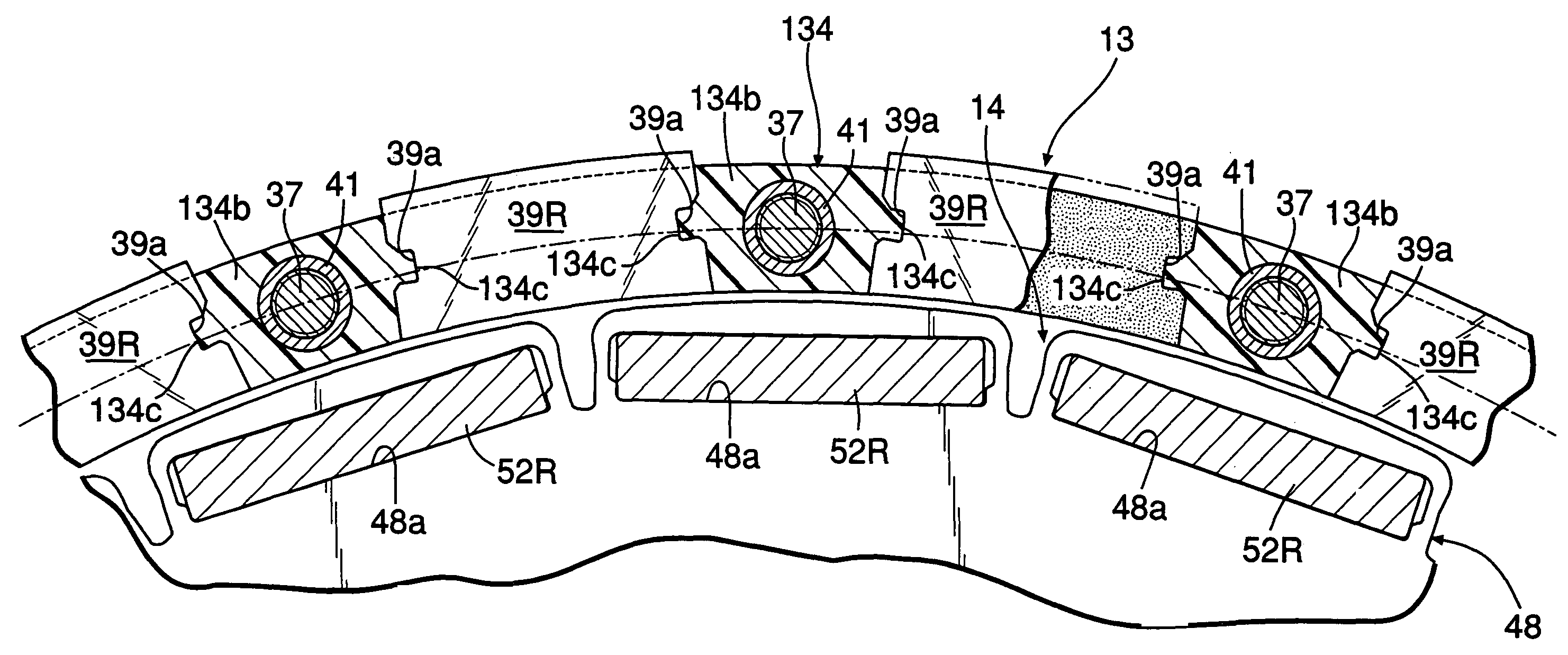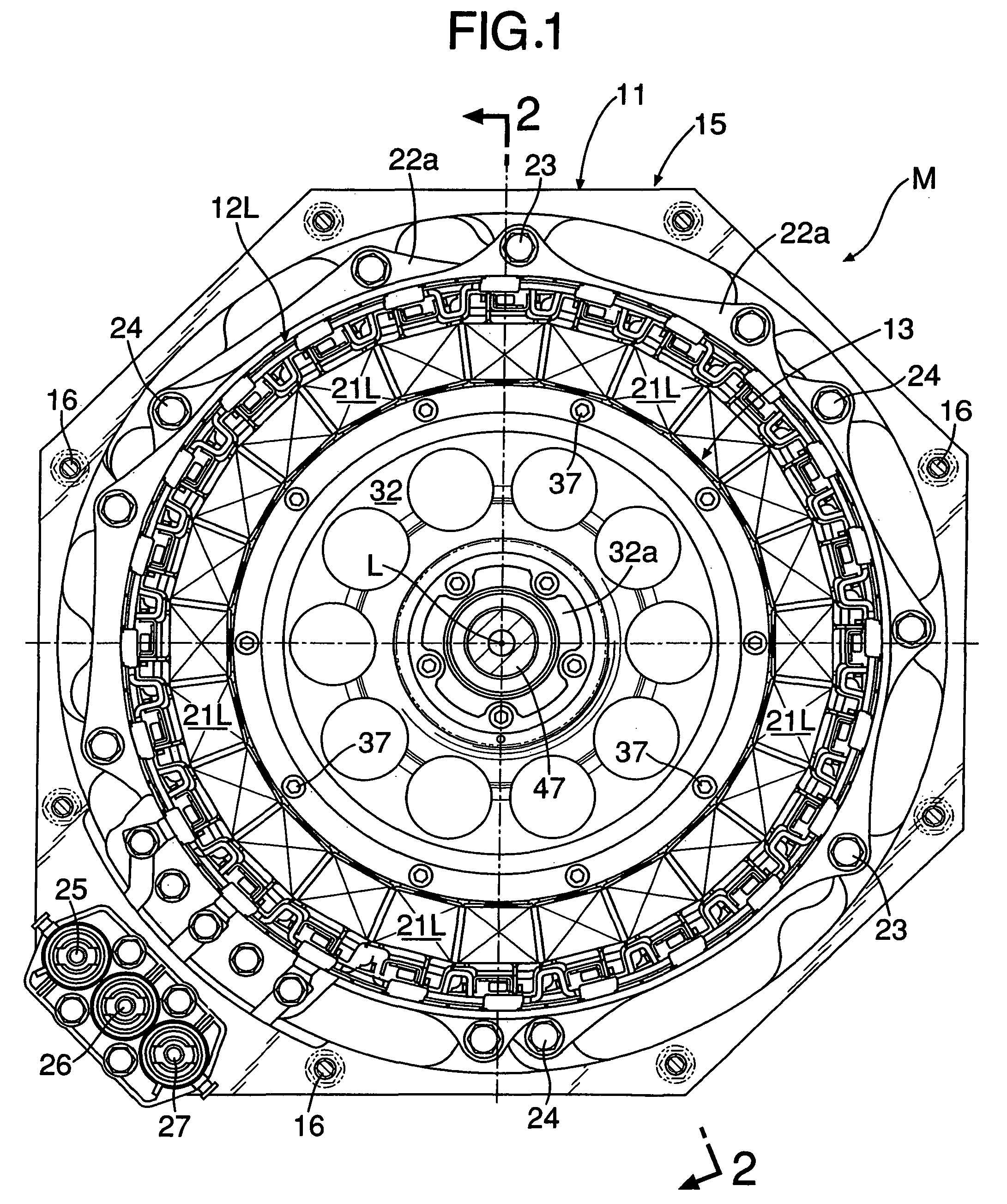Rotor for rotating electrical machine
a technology of rotating electrical machines and rotors, which is applied in the direction of rotating parts of magnetic circuits, dynamo-electric machines, and shape/form/construction of magnetic circuits, etc., can solve the problems of significant price increase, and complicated shapes of first and second rotor frames, so as to reduce heat dissipation and energy loss and the effect of reducing the eddy curren
- Summary
- Abstract
- Description
- Claims
- Application Information
AI Technical Summary
Benefits of technology
Problems solved by technology
Method used
Image
Examples
first embodiment
[0110]At first, the present invention will be described based on FIG. 1 to 20.
[0111]As shown in FIG. 10, an electric motor M of the embodiment is comprised of a casing 11 comprises an octagonal shape being shorter in the direction of an axis L, circular toroidal first and second stators 12L and 12R fixed in the inner periphery of the casing 11, a cylindrical outer rotor 13 being housed inside the first and second stators 12L and 12R and rotating on the axis L and a cylindrical inner rotor 14 being housed inside the outer rotor 13 and rotating on the axis L. The outer rotor 13 and the inner rotor 14 are relatively rotatable to the first and second fixed stators 12L and 12R and the outer rotor 13 and the inner rotor 14 are mutually relatively rotatable.
[0112]As illustrated in FIG. 1 and FIG. 2, the casing 11 is comprised of a main body part 15 having a bottomed octagonal cylinder shape and a lid portion 17 having an octagonal plate shape being fixed to an opening of the main body part...
second embodiment
[0177]Next, the present invention will be described based on FIG. 21.
[0178]The connection member 34 of the first embodiment is a solid member. However, the connection member 34 of the second embodiment is configured to be hollow by welding two stainless plates, for example, subjected to a press working. That structure lightens the connection member 34 further and reduces its substantial sectional area. Thereby, eddy current can be reduced further.
third embodiment
[0179]Next, the present invention will be described based on FIG. 22.
[0180]In the first embodiment, the first and second flange members 32 and 33 and the connection members 34 are comprised of different members. However, in the third embodiment, a half of the number of the connection members 34 is formed integrally with the first flange member 32. The remaining half thereof is formed integrally with the second flange member 33. The connection members 34 on the side of the first flange member 32 and the connection members 34 on the side of the second flange member 33 are alternately arranged in an assembled state. In that case, the material of the first and second flange members 32 and 33 is a weak magnetic material the same as the material of the connection members 34, that is, aluminum or aluminum alloy.
[0181]Also in that third embodiment, a portion where the connection members 34 on the side of the first flange member 32 are coupled with the second flange member 33 and a portion w...
PUM
 Login to View More
Login to View More Abstract
Description
Claims
Application Information
 Login to View More
Login to View More - R&D
- Intellectual Property
- Life Sciences
- Materials
- Tech Scout
- Unparalleled Data Quality
- Higher Quality Content
- 60% Fewer Hallucinations
Browse by: Latest US Patents, China's latest patents, Technical Efficacy Thesaurus, Application Domain, Technology Topic, Popular Technical Reports.
© 2025 PatSnap. All rights reserved.Legal|Privacy policy|Modern Slavery Act Transparency Statement|Sitemap|About US| Contact US: help@patsnap.com



